Single-Handed Society is Biggest
Class in Trans Superior
The Adventures of Odyssey
By Wally McMinn
The short version of the story is that Odyssey traveled to Duluth, MN and back from North Cape Yacht Club on Lake Erie. Here is a bit of the tale. Like all of the ambitious campaigns in the sailing world, I had a committed and tenacious support team. Her name is Ann, and she probably has her own impressions of the Odyssey’s adventures.
In 2005, the Great Lakes Singlehanded Society (GLSS) offered three
“Challenges”; the 27th Port Huron and 9th Chicago to Mackinac Island
Challenges, the Supermac Challenge (held every three years), and for the
first time, a singlehanded challenge in conjunction with the Trans Superior
International Yacht Race. Participation in these events was the reason
Odyssey headed north from North Cape Yacht Club on Lake Erie in late June.
The trip up the Detroit and St. Clair rivers is always charming, long and
slow. It does provide an opportunity for the crew (GLSS=count one) to see
what is working or not working, and to calibrate the mind and body to life
on the water.
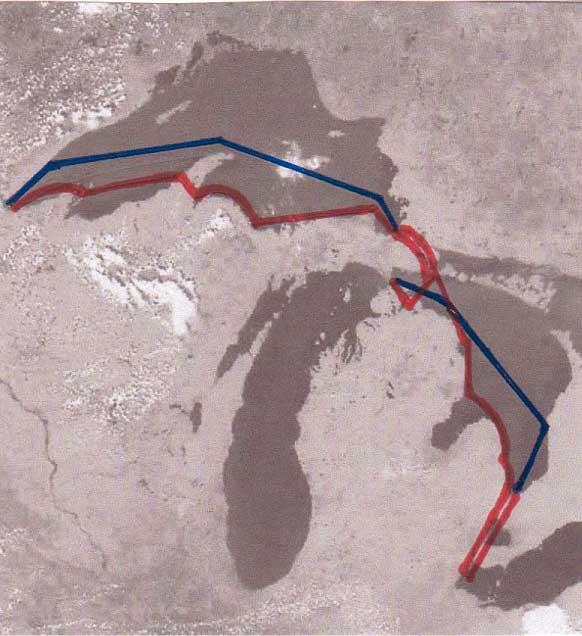 |
| The GLSS Challenges and the Deliveries and Returns |
The 2005 GLSS Port Huron to Mackinac Island Solo Challenge
The Port Huron to Mackinac Island Challenge is rated at 230nm with a
rounding off Goderich, Ontario then on up to Mackinac Island. The first leg
was an exhilarating close reach in 20+ kn of breeze. The Odyssey, a Catalina
400, likes these conditions and arrived near the turning mark near the front
of the twenty-three boats that started. This was good since it seems I had
jumped the gun by ten minutes at the start and rather than return and
restart, I opted to take the thirty minute penalty the race committee
offered as an alternative. I still don’t understand all those flags and
guns.
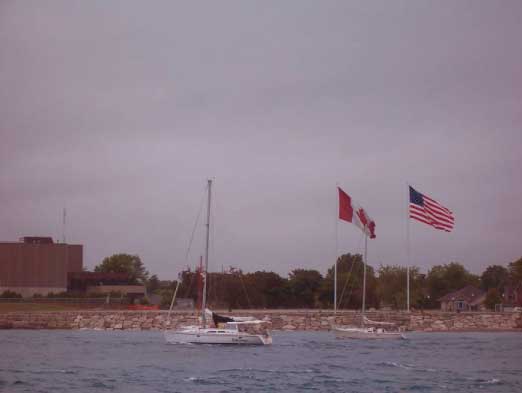 |
| Heading Past Sarnia, Ont. for the start of the Port Huron to Mackinac Solo Challenge. |
Most of the racers hand steer a good part of this leg as everyone is full of
energy and glad to get under way. After a wonderful first leg, and on
approaching Goderich, it became apparent something was wrong with Odyssey’s
autopilot. My intention had been to finish the Challenge to Mackinac Island,
and continue on with the second part of the event (the Supermac to Chicago).
With confidence the problem could be sorted out and solved, I rounded and
headed out into the lake for the long leg to the next turn at Presque Isle.
The wind and seas could not have been more cooperative. As sunset approached
the seas settled to a comfortable 3-4' roll with a steady wind of 13-15 kn.
I was able to balance the sail plan so the boat held course with the wheel
locked. Remembering the experience of fellow solo sailor Phil Rubright who
got locked in his lazaret when the top closed on him, I secured the cover
and headed into the basement to check on the linear drive unit and wiring
connections of the Autohelm 6000. Over the next hours of napping, tweaking
the sails and wheel, and tracing all of the wiring connections, it became
apparent I was not going to be able to find and fix the problem.
Solo sailors during long passages are good at playing mind games with
themselves, mine went something like this. I have to cross the lake anyway,
so why not keep going a bit. Once across, there are lots of harbors of
refuge. Perhaps the unit will start to work later. I have done this before,
let’s see how things go. Eventually the mind game was, I am more than half
way there, might as well hang in, and so on, and so on. The conditions
remained perfect with the usual beautiful sunset, starry night, Milky Way,
shooting stars, sunrise, and Ann’s tasty pasta salad for dinner, and again
for breakfast.
In spite of the distractions, Odyssey was still hanging in competitively and
remained in the front half of the fleet sailing pretty much on her own, and
on course. However, the wind always changes, and it did the next day. It
backed to the southwest and dropped below 10kn. Spinnaker time, and that was
a problem. Most of the fleet went through two to four spinnaker changes and
jibes during the last half of the event. I had to stick to the cruising
spinnaker, occasionally being able to pole it out a bit. Way underpowered
for the Odyssey. GLSS requirements stipulate we are to be tethered to the
jack lines from the time we leave the dock prior to the start until reaching
the dock at the finish. There were only so many dashes to the foredeck for
sail and pole adjustments possible with tether dragging along. It was
frustrating as I slipped back into the middle of the fleet, but I was still
making progress heading north, and eventually northwest.
Finally, after an elapsed time of about 54hr (up from 44+hr in 2004), the
Odyssey passed the green # 3 buoy opposite the Mackinac Island Yacht Club
and was greeted by the Race Committees’ official acknowledgement of
“Congratulations Odyssey, welcome to Mackinac Island”. With mixed emotions,
and limp arms, I had to inform the Committee that the Odyssey would have to
stop at the Island due to gear failure and not continue on to Chicago as
part of the Supermac event. It simply would not have been prudent seamanship
to attempt another 280nm of hand steering after the roughly 36hrs and almost
180nm just completed without a functioning autopilot. I was not going to
complete the longest freshwater race in the world this year.
The revelry and party on the Island are always an incentive to sail fast and
finish the Solo Challenges. Even when participants withdraw from a Challenge
they usually find a way to get to the Island for the festivities. This year
most of the time was spent, with the help of GLSS resident engineer Bob
VanEck, Harold Beaton, and several other sailors who happened to be around
the docks, sorting out what was wrong with the autopilot. As so often
happens, other North Capers were out and about on the lakes and on the
Island. Past Commodore (PC) Shelly Rosen, PC Mike D’Arcangelo, Terry Brown,
Larry Jocob, and Keith Sponer were cruising the Straits area aboard the
yacht Kestrel.
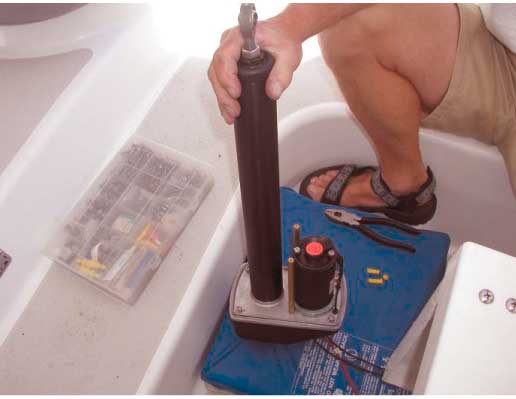 |
| The Tired Old Autopilot Drive Unit. |
After testing every connection while spending several hours on the cell
phone with the Raytheon techs, the conclusion was that the drive unit (ten
years old) had worn out and would need to be overhauled in their shop.
Instead of opting for the uncertain prospects of a fix, I ordered a new (and
upgraded) drive unit through Defender. The unit was delivered the next day
to Duncan Bay Boat Club in Cheboygan where the boat was to be laid over
until time to head for Sault St. Marie and the Trans Superior. Again, with
the help of Bob, the unit was installed the day it arrived and passed
initial sea trials around Bois Blanc Island. During these trials, we were
joined by Tom and Barb Munson who were at Duncan Bay following Tom’s blue
flag winning performance in the Doublehanded Society’s Huron Challenge.
With the prospects of the Trans Superior now looking good, the Odyssey was
laid over at Duncan Bay while I headed back to work and the real world for a
few weeks. For those who have not been there, Duncan Bay, at Cheboygan is
one of the nicest, best run marinas in the area. The management and staff
are accommodating and attentive and they seem willing to help with both
short and longer stays of transient boaters. The Odyssey claimed victory on
Lake Huron, with the “Lakes” and gremlins winning Lake Michigan. Lake
Superior would be the tie breaker.
The 2005 GLSS Sault St. Marie to Duluth Trans Superior Solo Challenge
The Trans Superior International Yacht Race is rated at 338nm beginning at
Gross Cap at the bottom of Whitefish Bay, leaving Copper Harbor to port, and
finishing at the lift bridge entrance to Duluth Harbor. It is held every two
years, and for the first time allowed singlehanded participants.
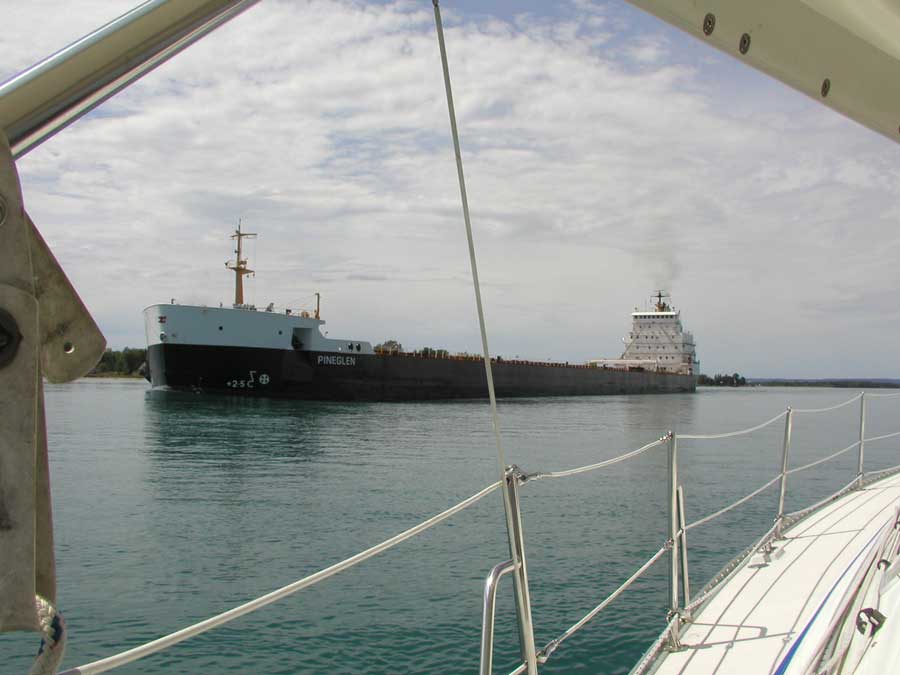 |
| A fellow traveler on the St. Marys River. |
The Lake Superior Yachting Association was the overall sanctioning entity,
but allowed GLSS to select the solo participants and define the boat and
equipment requirements. The Algoma Sailing Club of Sault St. Marie, Ontario
and the Duluth Y. C. were the joint host clubs doing a great job of
coordination, communication, and hosting the pre race skippers and post race
parties.
The Odyssey’s trip from Cheboygan past Detour, MI and up the Saint Marys
River was pleasant and uneventful until the alternator belts disintegrated
with a loud bang. From the helm it was easy to figure out what had happened
as the engine immediately started to overheat. Suddenly the 600-1000 foot
lakers, which were also making the passage in both directions, ceased to be
the delightful diversion and entertainment, and looked mighty menacing.
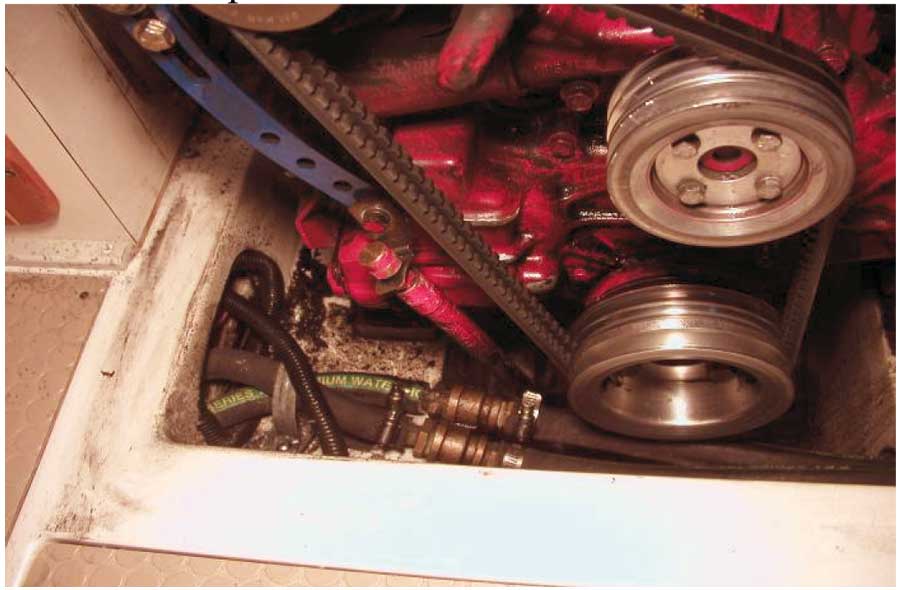 |
| Still a mess even after cleaning up and new belts. |
I always make it a policy to have the chart at the ready when on the rivers,
which is especially important on the St. Marys as the depths often vary from
the dredged 28-30' in the channel, to 2-3' just a few yards outside. A quick
look at the chart indicated a nice bar in 8-10' of water just downstream
from my position. Using what steerage momentum the boat still had after
shutting the engine down, I was able to do an “S” turn to starboard, then
back to port and get out of the channel. A quick dash to the foredeck,
anchor locker open, retaining pin out, and down went the plough. I had
previously taken the time to tidy up the anchor lines, so there were no
kinks as it played out. Pure luck, and time to pause and reflect on the
options. Fortunately, the weather was clear and I had a nice cup of cold
coffee left.
The scene in the engine compartment was ugly. Both belts were shattered into
bits and pieces, with none longer than a few inches. There was dust
everywhere along with spatters of what later turned out to be oil. Belt cord
fragments had also wrapped around the shaft between the block and the
pulley. After cleaning up the mess and unwinding as many of the belt
fragments as I could get to, I decided to install the extra alternator belts
I had on board and try to limp on up the rest of the way to the Kemp Marina
at the Sault. It was a relief to see the temperature gauge return to, and
stay, in the normal range for the rest of the trip.
The Kemp Marina is located in the American Sault just down stream from the
locks, and is an excellent place to stay. The only other option for most of
our boats is the Bondar Marina just across the river in the Canadian Sault.
It is also very good. The Odyssey’s wine cellar is empty for these events,
so it was particularly nice to see Ann arrive and head into town for a
victory (of sorts) libation and dinner.
After further clean up and belt adjustment everything seemed to be ok with
only a small bit of oil leaking. I have no idea what caused the belt
failure, perhaps the belts themselves were flawed. The Trans Superior was a
week away and I had to return to work again so the Odyssey sat comfortably
in the Sault. Once through the Lock there was only the trip to Gross Cap and
the start of the race.
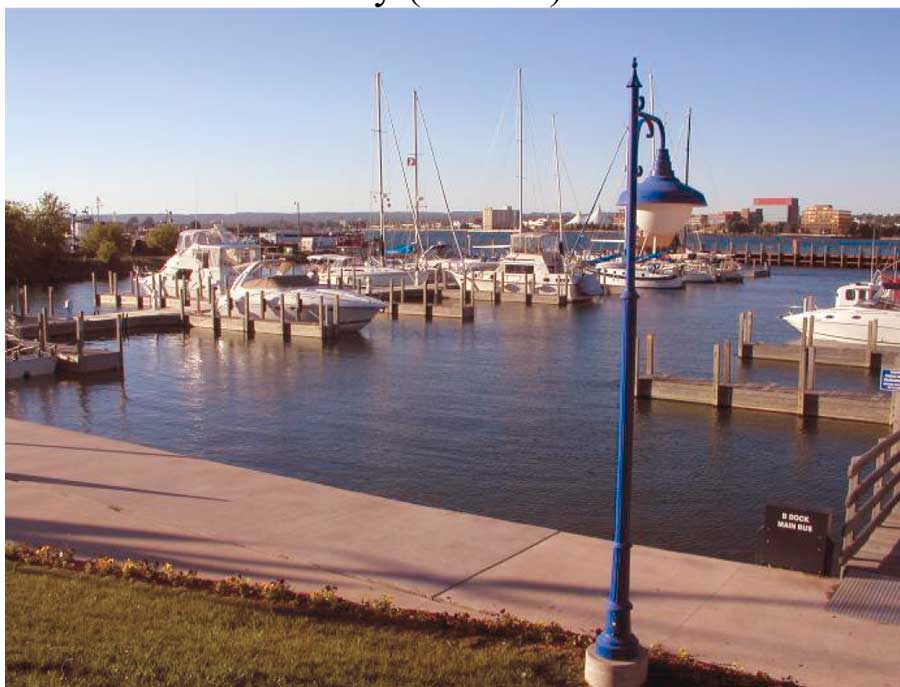 |
| The Kemp Marina at Sault Ste. Marie, MI. |
On Saturday morning, August 6th eighteen crewed and twelve singlehanded
boats emerged from the Kemp and Bondar marinas and headed into the MacArthur
Lock at the Sault. The gathering is somewhat of a festival as many of the
boats send a crew member up the mast while those on deck celebrate with
various good luck rituals. This year’s event drew a nice group of observers
as the Locks celebrated their 150th anniversary. The fleet was as diverse as
could be imagined ranging in size from the seventy foot mega crewed Santa
Cruz 70s (Colt 45 and Stripes) down to the diminutive Ranger 23 (Jacelyn)
crewed by one. The rafted fleet was gingerly raised the twenty feet to the
Lake Superior level.
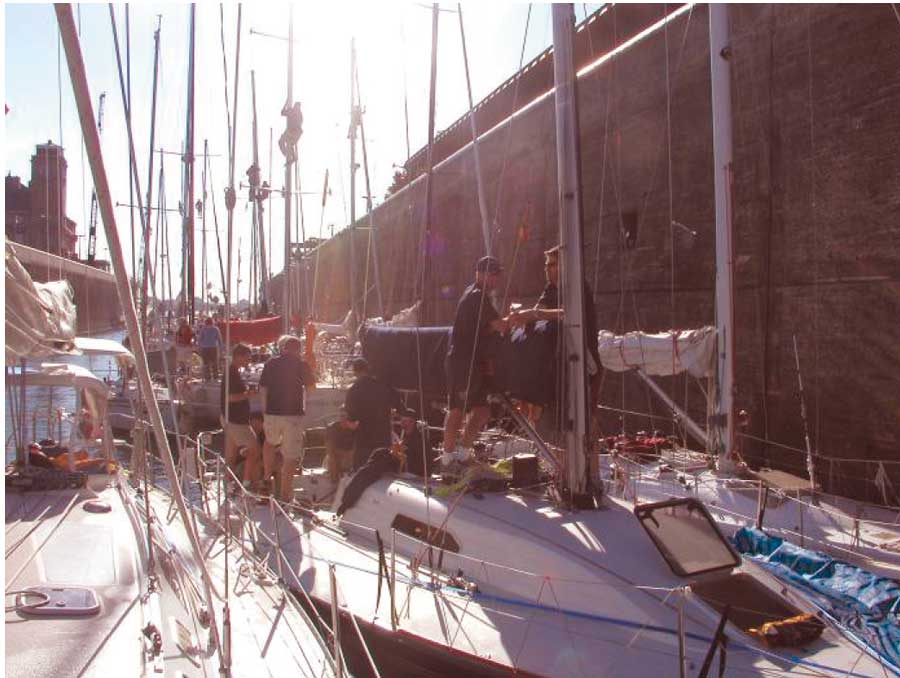 |
| The rafted fleet in the lock with crews in the rafters. |
The starting line is 10-12 miles from the Locks at Gross Cap at the base of
Whitefish Bay. The fleet had a leisurely 2-3hr trip up the river and
gathered around the starting line for what turned out to be a drifter start
at 1:00pm. As a final check, I took a peek at the engine compartment and was
dismayed to find a mess of oil spattered everywhere on the front of the
engine and compartment. I later found out the alternator belt fragments had
forced the shaft seal into the engine and broken the seal. It only leaked
when the engine was running, and since the Trans Superior was to be a
sailing event, there was no way I was going to turn back. I had eight quarts
of oil aboard so figured that would be enough to get me off the lake if
needed. The Odyssey has about 750 amp hours of battery capacity as well as
backup navigation lights. Fortunately, the engine has a separate pan under
it which collected the entire spill, most of which was soaked up into the
absorbent matting. None of it ended up in the ships bilge, or was lost
overboard. The major battery draws were the autopilot (which worked
perfectly), navigation lights, and the occasional use of the radar. The
instruments used very little.
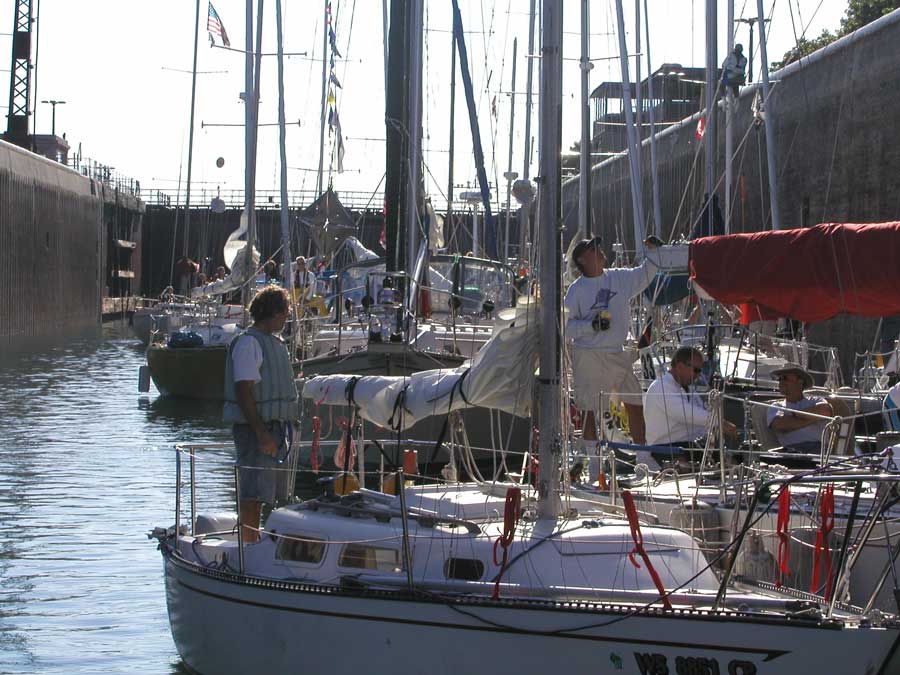 |
| Tom Agerter aboard Jacelyn. |
A couple of hours after the light air start, the breeze began to fill in and
build. It turned out to be a beautiful beam reach with spinnakers to
Whitefish Point, then a close reach toward the Keweenaw. The 70’s and 50’s
were gone, but the rest of the fleet stayed pretty much strung out along the
rhumb line. The freighter traffic was light and never a factor as they
separated into the up bound and down bound lanes. As breezes built to
between 15kn and 20kn we all enjoyed an exhilarating ride into a spectacular
sunset, through the night, and the next day. The seas never were a factor in
spite of the fresh breezes for over a day and the 40-60 mile fetch from the
UP’s north shore. What a ride, it was worth the trip.
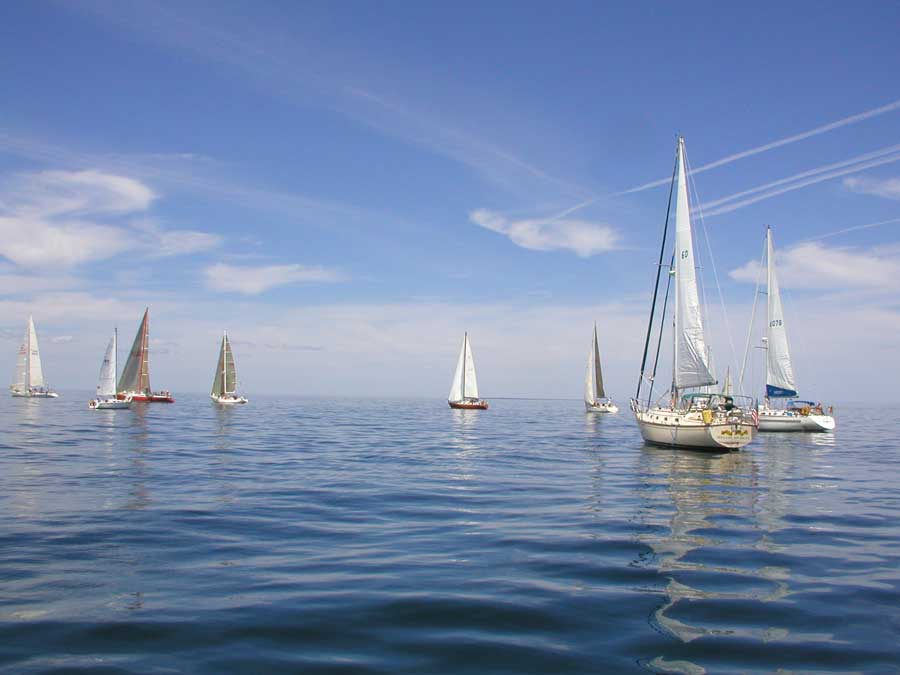 |
| A drifter start to the Trans Superior. |
Flying Across Lake Superior
As we approached the Keweenaw the winds began to go away and we were stuck
in those inevitable dead zones, with bits of puffs between. On rounding, we
finally had to get to work and do some sailing into light variable breezes.
Fortunately, there were also several hours of nice wind between the lulls as
the fleet began to either tack along the rhumb line, or head toward the
west. I chose to skip the tacks and stay on a port tack as far as I could
go. That turned out to be a lucky decision as a spectacular storm front
passed in front of us the night before finishing. The storm included a 6-8hr
lightning display from Duluth to the Apostle Islands. It turned out I was
not the only one who slowed the boat down to avoid sailing into it.
The finish of the race turned out to be much like the start for most of the
fleet. Most had to sit in calm, windless waters within sight of the lift
bridge entrance to Duluth’s harbor. After several hours of drifting, several
of us were checked out by homeland security patrol boats who wanted to be
sure we were race participants, and not some bad guys checking out this
critical port. On finally drifting across the finish line, the Odyssey got a
rousing cheer from the tourists and finish line committee posted at the end
of the pier. I think it is safe to say, every boat finishing was warmed by
the reception.
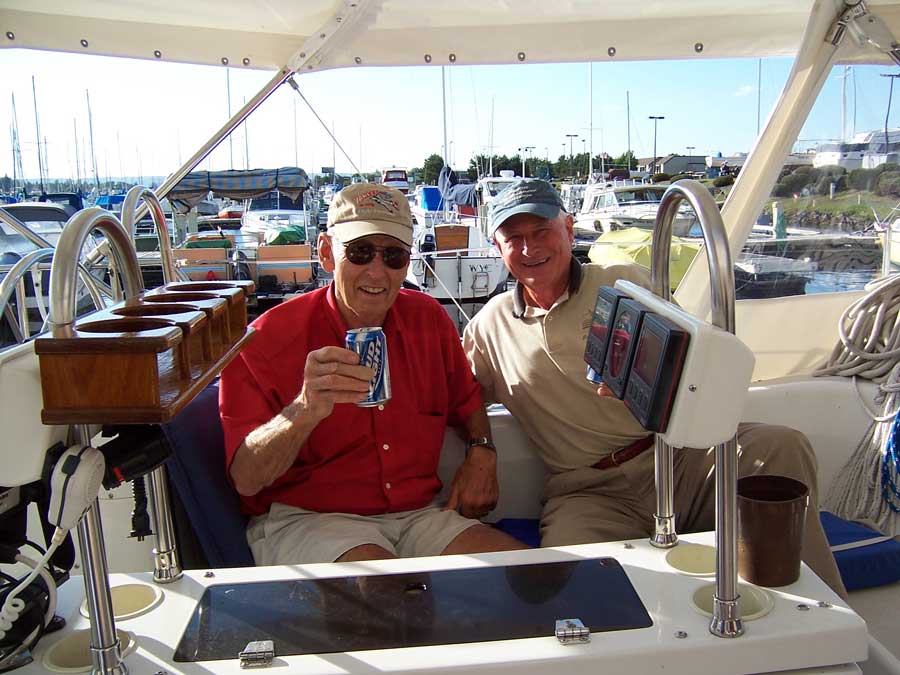 |
| Tom Munson and Hans Anderson in Duluth. |
The Committee met each boat at the dock at the Duluth Aquarium with a hug
and a bottle of rum. Without asking, they seemed to sense our first
priorities after securing the boats were to find a beer, a shower, and check
in with home. The elapsed times for the fleet ranged from 46hr27min. (Colt
45) to 101hr37min (a singlehander). The Odyssey finished in 76hr20min. Ten
of the twelve singlehanders who started, finished. The two who withdrew did
so on the first day when they had rig failures as the winds freshened.
I was not at all surprised to find another North Caper wandering the dock at
the Duluth Aquarium. Seems Lauren Watkins (Bright Eyes) had also
participated as crew aboard the yacht Shanti.
Odyssey needed repairs prior to returning to Lake Erie. As luck would have
it, GLSS member Eric Thomas is the service manager at the Barker’s Island
Marina within the Duluth / Superior harbor. This marina is an excellent,
full service facility, and they were able to expedite the engine repairs. In
addition to replacing the shaft seal, a new alternator was installed as it
had been damaged by dust, belt fragments, and oil. Even though it continued
to work, a number of the contacts inside were melted and distorted by
overheating.
Duluth is a vibrant community with many fine activities and restaurants in
the downtown area bordering the harbor. There was no problem finding things
to do between overseeing the boat repairs, joining the members of the Duluth
Yacht Club for their activities, and waiting for Ann to arrive. She and her
sister Joyce had come up to join in the fun and deliver GLSS members Tom
Munson and Hans Anderson who were joining me for the return trip to Lake
Erie.
With the successful completion of the 2005 Trans Superior, Odyssey won the
season’s GLSS Challenges, two out of three.
Wally McMinn is a member of the Great Lakes Singlehanded Society in
Grosse Pointe Farms, Michigan.
Info on Trans Superior Yacht race, www.transsuperior.com.
Info on Great Lakes Singlehanded Society, www.solosailor.org.
All contents are copyright (c) 2007 by
Northern Breezes, Inc. All information contained within is deemed reliable
but carries no guarantees. Reproduction of any part or whole of this
publication in any form by mechanical or electronic means, including
information retrieval is prohibited except by consent of the publisher.